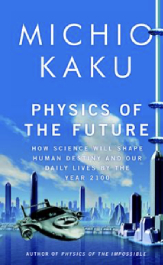Let’s Hope the Robots Are Nice –No need to learn Mandarin—your universal translator will do the job. And nanotechnology will build the thing.
Do not rage against the machine. Embrace the machine.
That is the core message of Michio Kaku’s “Physics of the Future.” Despite its title, the book is not so much about physics as it is about gadgets and technology, described by Mr. Kaku—professor, blogger and television host—on a wide-ranging tour of what to expect from technological progress over the next century or so.
Much of the terrain Mr. Kaku surveys will be familiar to futurists, but less technically oriented readers are likely to find it fascinating—and related with commendable clarity. The changes that Mr. Kaku expects range from the readily foreseeable to the considerably more esoteric.
Augmented reality—in which useful data overlay what we see with our eyes—already exists in rudimentary form on smartphones, but Mr. Kaku predicts a time, only a decade or two away, when a much denser information stream will be fed directly to our retinas by contact lenses or optical implants. Want to fix a car, perform emergency surgery, or prepare a gourmet meal? The app will tell you what to do—and guide your work. Have trouble learning a foreign language? Expect a useful universal translator to do the work for you. And the ability to connect computers directly to human nervous systems will drastically improve the lives of those who are paralyzed, blind or deaf—as it is already beginning to do. Eventually, we may know the sort of virtual worlds illustrated in science-fiction novels like Greg Egan’s “Permutation City.”
Medicine will be revolutionized as well, with bathroom sensors that warn our doctors—or their artificial-intelligence robo-assistants—of impending health problems in time for routine preventive care. Magnetic-resonance imagers that share data over the Internet will be the size (and cost) of blow-dryers, allowing easy follow-up care.
Mr. Kaku is a big fan of private space-travel companies like Virgin Galactic and Blue Origin, and he believes that they will over time lead to the kind of drastic cost reduction that has eluded government efforts. Looking further along, he sees humans colonizing the solar system, “terraforming” Mars to make its climate more Earth-like and dispatching probes—perhaps tiny thimble-sized probes using molecular-level nanotechnology—to ot
Nanotechnology will be at first rare and expensive and, by the end of the century, commonplace and cheap, largely fulfilling the predictions of pioneering scientists such as Richard Feynman and Eric Drexler. In a world where programmed molecular assembly powered by sunlight can produce almost anything out of raw materials, material wealth will be widespread. That’s bad news for social climbers, who will need to find new status markers to tell them how they’re doing.
Artificial intelligence will continue to grow, he says, as the size of transistors continues to shrink, until we reach a silicon plateau in 20 years or so, after which the growth of computer power will slow dramatically unless nanotechnology provides a new path. Silicon Valley, Mr. Kaku warns, could become a 21st century rust belt if this path doesn’t appear. But he is largely untroubled by fears that we will face killer robots or other forms of hostile AI.
He is sanguine for two reasons. First, though artificial intelligences may ultimately wind up much smarter than human beings, we won’t be standing still either. We’re likely to embrace all sorts of upgrades—like those helpful contact lenses—that will make us much more competitive. Second, Mr. Kaku believes that research into “friendly AI”—computers programmed to want to be nice to humans—will likely bear fruit as well. The result will be more like the benign man/machine collaboration envisioned by Ray Kurzweil and other futurist scientists than the apocalyptic scenes in the “Terminator” movies. That isn’t to say that there won’t be disruptions—today’s unemployment levels may look reasonable once the advance of machines really kicks in.
I am inclined to agree with Mr. Kaku’s largely optimistic view of the future. But I am also reminded of science-fiction writer Vernor Vinge’s warning about technology empowering individuals to the point that it could put “world-killer weapons in the hands of anyone having a bad hair day.”
The most disturbing passage in “Physics of the Future” doesn’t concern the future; it’s about the present. In that passage, Mr. Kaku recounts a lunchtime conversation with physicist Freeman Dyson at Princeton. Mr. Dyson described growing up in the late days of the British Empire and seeing that most of his smartest classmates were not—as prior generations had been—interested in developing new forms of electrical and chemical plants, but rather in massaging and managing other people’s money. The result was a loss of England’s science and engineering base.
Now, Mr. Dyson said, he was seeing the phenomenon for the second time in his life, in America. Mr. Kaku, summarizing the scientist’s message: “The brightest minds at Princeton were no longer tackling the difficult problems in physics and mathematics but were being drawn into careers like investment banking. Again, he thought, this might be a sign of decay, when the leaders of a society can no longer support the inventions and technology that made their society great.”
The future belongs to those who show up. Mr. Kaku’s description of that future is an appealing one. But will we show up?
Summary written by Mr. Reynolds is professor of law at the University of Tennessee. He hosts InstaVision on PJTV.com.
lcome to WordPress. This is your first post.lcome to WordPress. This is your first post.lcome to WordPress. This is your first post.lcome to WordPress. This is your first post.lcome to WordPress. This is your first post.lcome to WordPress. This is your first post.lcome to WordPress. This is your first post.lcome to WordPress. This is your first post.lcome to WordPress. This is your first post.lcome to WordPress. This is your first post.
